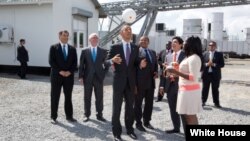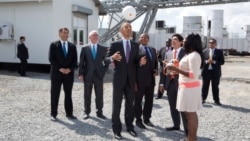Lack of electricity is one of the great obstacles to development in sub-Saharan Africa. Nearly seventy percent of sub-Saharan Africans — some 600 million people — lack access to electricity, forcing them to spend significant amounts of their income on costly and unhealthy forms of energy, like diesel fuel to run factory generators and smoky and scarce wood for indoor fires for cooking.
That is why last summer, President Barack Obama announced Power Africa -- an initiative that will significantly increase the number of people with access to electricity in Sub-Saharan Africa. Working with governments, international and African businesses, non-governmental organizations, and institutions including the World Bank, the European Union and the African Development Bank, the United States hopes to expand the capacity and reach of existing power grids, and build mini-grids and off-grid systems to power Africa.
By tapping many potential sources of energy -- sun, wind, water or heat from the earth’s core and Africa’s abundant supplies of natural gas -- the Power Africa initiative is already increasing power generation across the continent.
To date, the U.S. Government has committed more than $7 billion in financial support and loan guarantees, as well as coordinated support and expertise of 12 U.S. government agencies. The U.S. Overseas Private Investment Corporation, or OPIC, which mobilizes private capital to help solve critical challenges in developing countries, committed $1.5 billion to Power Africa for its first five years. The Millennium Challenge Corporation added another billion, and the U.S. Agency for International Development, will provide $285 million.
Today, Power Africa is set to clear the final hurdle—ratification by the U.S. congress, where it enjoys strong bipartisan support in both chambers. Once it passes, it will be signed by President Obama.
The electricity that allows businesses to flourish, clinics to store vaccines, and students to study long after dark will soon become available to more people living in Sub-Saharan Africa.
Power Africa will change their world.
That is why last summer, President Barack Obama announced Power Africa -- an initiative that will significantly increase the number of people with access to electricity in Sub-Saharan Africa. Working with governments, international and African businesses, non-governmental organizations, and institutions including the World Bank, the European Union and the African Development Bank, the United States hopes to expand the capacity and reach of existing power grids, and build mini-grids and off-grid systems to power Africa.
By tapping many potential sources of energy -- sun, wind, water or heat from the earth’s core and Africa’s abundant supplies of natural gas -- the Power Africa initiative is already increasing power generation across the continent.
To date, the U.S. Government has committed more than $7 billion in financial support and loan guarantees, as well as coordinated support and expertise of 12 U.S. government agencies. The U.S. Overseas Private Investment Corporation, or OPIC, which mobilizes private capital to help solve critical challenges in developing countries, committed $1.5 billion to Power Africa for its first five years. The Millennium Challenge Corporation added another billion, and the U.S. Agency for International Development, will provide $285 million.
Today, Power Africa is set to clear the final hurdle—ratification by the U.S. congress, where it enjoys strong bipartisan support in both chambers. Once it passes, it will be signed by President Obama.
The electricity that allows businesses to flourish, clinics to store vaccines, and students to study long after dark will soon become available to more people living in Sub-Saharan Africa.
Power Africa will change their world.
















